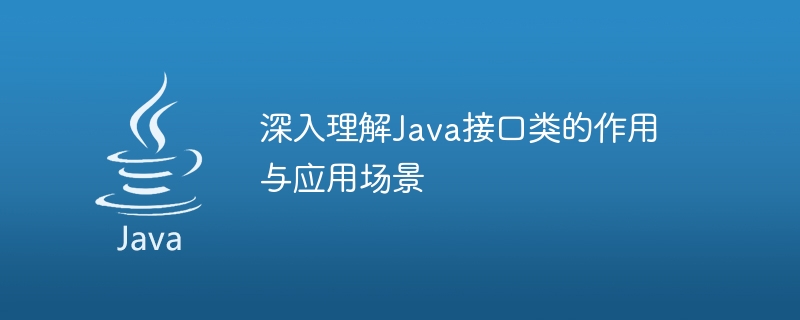

In-depth understanding of the role and application scenarios of Java interface classes
Introduction:
Java interface is an important language feature used to define between classes A set of public methods and constants. Interfaces provide a mechanism to achieve polymorphism, allowing different classes to implement the same interface, so that the implementation logic can be replaced without changing the original code. This article will deeply explore the role and application scenarios of Java interface classes, and further deepen understanding through specific code examples.
1. The role of interface classes
2. Application scenarios of interface classes
The following is a simple example that defines an interface class Listener and has a callback method onEvent(). The specific class implements the interface and implements specific logic through the callback:
public interface Listener {
void onEvent();
}
public class EventSource {
private Listener listener;
public void registerListener(Listener listener) {
this.listener = listener;
}
public void fireEvent() {
// 触发事件
if (listener != null) {
listener.onEvent();
}
}
}
public class EventListener implements Listener {
@Override
public void onEvent() {
// 处理事件的逻辑
System.out.println("处理事件");
}
}
public class Main {
public static void main(String[] args) {
EventSource eventSource = new EventSource();
eventSource.registerListener(new EventListener());
eventSource.fireEvent();
}
}The following is an example that defines an interface class Fruit and its two implementation classes Apple and Banana. Where you need to use the Fruit class, you can use Apple or Banana instead, thereby realizing class replacement:
public interface Fruit {
void eat();
}
public class Apple implements Fruit {
@Override
public void eat() {
System.out.println("吃苹果");
}
}
public class Banana implements Fruit {
@Override
public void eat() {
System.out.println("吃香蕉");
}
}
public class Main {
public static void main(String[] args) {
Fruit apple = new Apple();
apple.eat();
Fruit banana = new Banana();
banana.eat();
}
}The following is an example that defines two interface classes Animal and Flyable to achieve the effect of multiple inheritance:
public interface Animal {
void eat();
}
public interface Flyable {
void fly();
}
public class Bird implements Animal, Flyable {
@Override
public void eat() {
System.out.println("吃虫子");
}
@Override
public void fly() {
System.out.println("飞上天空");
}
}
public class Main {
public static void main(String[] args) {
Bird bird = new Bird();
bird.eat();
bird.fly();
}
}Conclusion:
In Java, the interface class is A very important language feature that has the function of defining class behavior specifications, implementing polymorphism, and reducing class coupling. This article provides an in-depth discussion of the role and application scenarios of interface classes through detailed code examples. I hope that readers can have a more in-depth understanding and application of Java interface classes by studying this article.
The above is the detailed content of Research on the role and application scenarios of Java interface classes. For more information, please follow other related articles on the PHP Chinese website!
 How to configure web server
How to configure web server
 Solution to the problem that setting the Chinese interface of vscode does not take effect
Solution to the problem that setting the Chinese interface of vscode does not take effect
 hiberfil file deletion method
hiberfil file deletion method
 Mysql database migration method
Mysql database migration method
 Promoting ads
Promoting ads
 499 error code ending solution
499 error code ending solution
 How to solve tomcat startup crash
How to solve tomcat startup crash
 The difference between PD fast charging and general fast charging
The difference between PD fast charging and general fast charging




